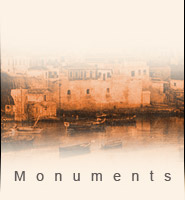



The town centre began to take shape under Arab rule, was developed in the second Byzantine period and assumed its present layout in Venetian times. The main thoroughfare was the road linking the port to the town's central square - the present day 25th August St. or Ruga Maistra of Venetian times.
All activity grew up around the main square in Chandax, where the imposing Morosini fountain was erected in the late Venetian period. It was there that the magnificent Ducal Palace was built, along with the official church dedicated to St. Mark, the Venetian club (Loggia), the General's residence (Palazzo del Capitano Generale) and the Governor's mansion (Governatore).
Today, over three centuries after the Venetian era, the city's inhabitants move in much the same space. The Loggia has been transformed into an elegant Town Hall, while the Basilica of St. Mark houses the Municipal Art Gallery. The square surrounding the Morosini fountain continues to draw people of all ages. Yet other buildings have either disappeared completely or left but a few well-hidden traces, which have stood the test of time immured in subsequent structures.

Detail from the Maneas Klontzas Codex showing the Ruga Maistra, the main thoroughfare linking the port with the town's main square. This was the area where the administrative centre grew up (Maneas Klontzas, Traeger Collection)









